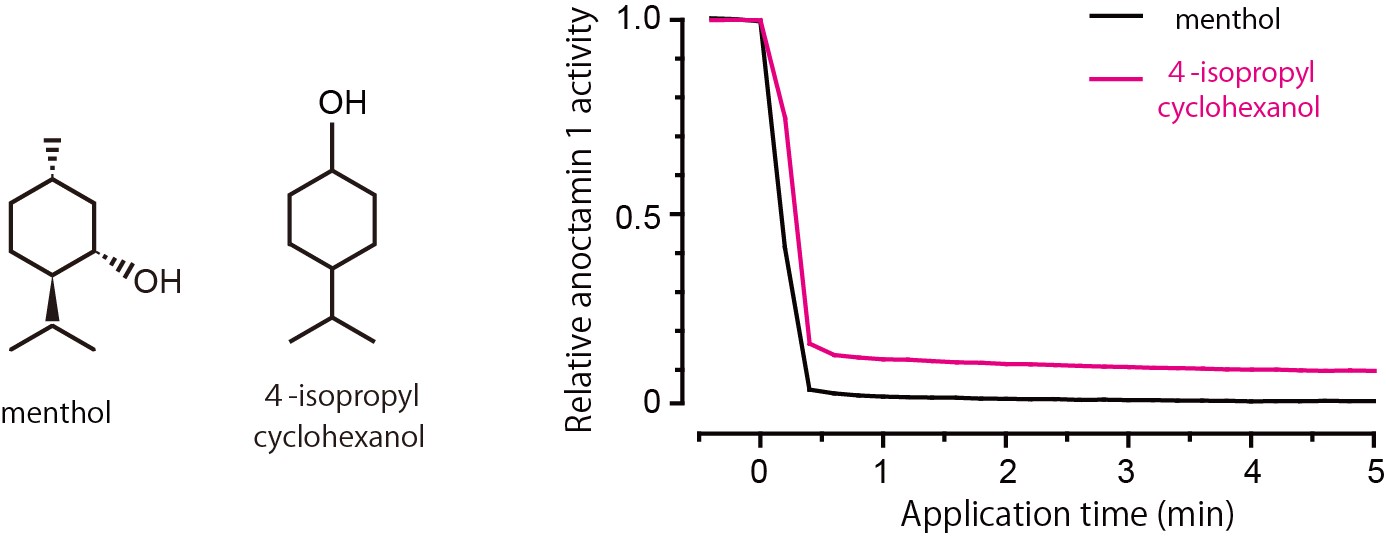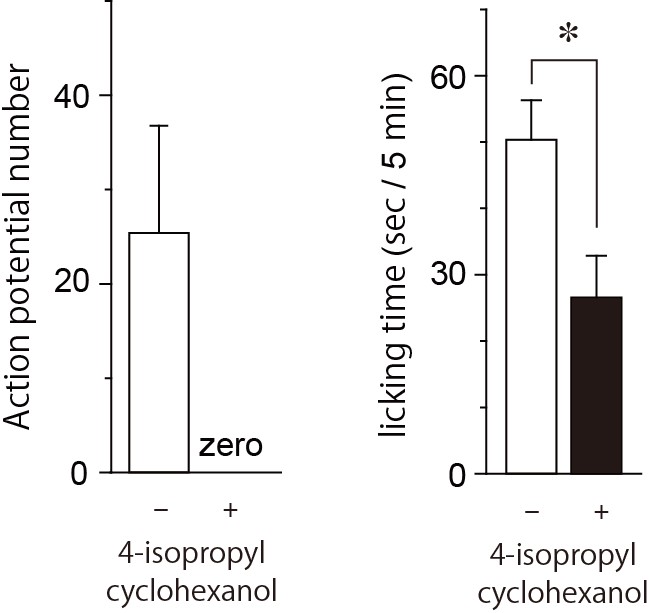Activation of several ion channels by nociceptive stimuli in peripheral sensory neurons induces pain sensation. Especially, anoctamin 1, TRPV1 and TRPA1 are attractive targets for pain treatment. Drs. Yasunori Takayama, Makoto Tominaga (Okazaki Institute for Integrative Bioscience) and Hidemasa Furue (Hyogo College of Medicine) found that menthol inhibits anoctamin 1. Furthermore, 4-isopropylcyclohexanol, one of the menthol analogues, was found to inhibit anoctamin 1, TRPV1 and TRPA1. This analogue suppressed pain-related behaviors in mice induced by capsaicin through the TRPV1-anoctamin 1 interaction. These findings suggest that 4-isopropylcyclohexanol is an important seed chemical for the development of new painkillers. This study will be published in Scientific Reports.
Prof. Tominaga and his colleagues previously reported the physiological significance of interactions between TRP channels and anoctamin 1 (ANO1), a calcium-activated chloride channel. For instance, TRPV4-ANO1 interaction is involved in cerebrospinal fluid secretion from choroid plexus in mice, and TRPV1-ANO1 interaction causes pain enhancement. Interestingly, menthol and its analogues were found to inhibit TRP channels and ANO1 during the project to find other TRP-ANO1 interactions.
Firstly, menthol, a TRPM8 agonist, was found to strongly inhibit ANO1. Then, Prof. Tominaga and his colleagues focused on the chemical structure of menthol, and identified 4-isopropylcyclohexanol as a potent ANO1 inhibitor (Fig 1).
4-isopropylcyclohexanol also inhibited TRPV1 and TRPA1 both of which are well known to be involved in pain and itch sensations. Therefore, it was suggested that 4-isopropylcyclohexanol has an analgesic effect in vivo. Indeed, 4-isopropylcyclohexanol inhibited capsaicin-induced action potential generation in mouse sensory neurons and pain-related licking behaviors (Fig 2).
Prof. Tominaga said “our findings provide an interesting chemical which inhibits multiple ion channels involved in nociception. This would lead to the development of novel painkillers”.
This study was supported by JSPS KAKENHI Grant Numbers JP 15K19197, JP 15H02501 and Kato Memorial Bioscience Foundation.

(left) Chemical structures of menthol and 4-isopropylcyclohexanol
(right) Relative anoctamin 1 activity with time of chemical application. Both menthol and 4-isopropylcyclohexanol strongly inhibited anoctamin 1 activity.

(left) 4-isopropylcyclohexanol effects on sensory neurons. Capsaicin-evoked action potential generation was completely inhibited by 4-isopropylcyclohexanol.
(right) Average time of a pain-related behavior (hind-paw licking). Capsaicin-induced pain-related behavior was significantly suppressed by concomitant application of 4-isopropylcyclohexanol with capsaicin. * P < 0.05.
Menthol has been used for its anti-nociceptive effects for more than one thousand years while the mechanisms are not well understood. The current study shows that menthol exhibits the anti-nociceptive effects through the inhibition of TRPV1 and anoctamin 1. Moreover, 4-isopropylcyclohexanol, a menthol analogue with simpler structure, inhibited several ion channels involved in pain and itch sensations. These findings could lead to the development novel anti-nociceptive and anti-pruritic agents, especially the ones applied topically.
4-isopropylcyclohexanol has potential analgesic effects through the inhibition of anoctamin 1, TRPV1 and TRPA1 channel activities.
Yasunori Takayama, Hidemasa Furue, Makoto Tominaga.
Scientific Reports. 2017
<about this study>
Division of Cell Signaling, Okazaki Institute for Integrative Science (National Institute for Physiological Sciences), National Institutes for Natural Sciences
Professor Makoto Tominaga
Projected assistant professor Yasunori Takayama
<about public relations>
Research Enhancement Strategy Office, National Institute for Physiological Sciences, National Institutes for Natural Sciences
TEL: 0564-55-7722、FAX: 0564-55-7721
email: pub-adm@nips.ac.jp


National Institute for Physiological Sciences (NIPS)